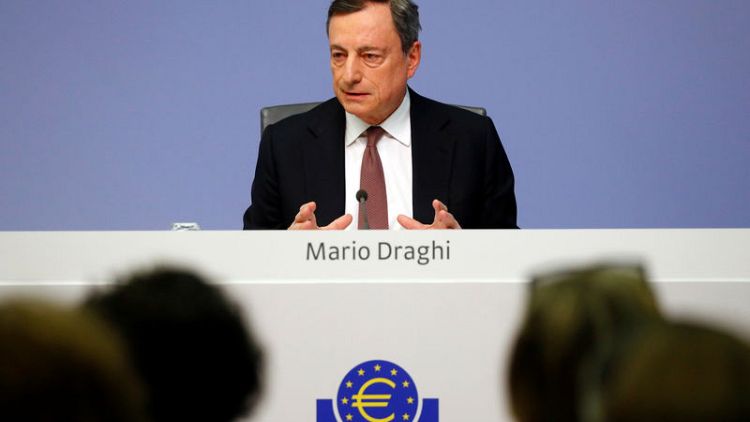By Dhara Ranasinghe
LONDON (Reuters) - Mario Draghi's dramatic Tuesday hints of further monetary easing by the European Central Bank has stabilized collapsing euro zone inflation expectations, but the departing ECB chief will struggle to calm market fears of Japan-style economic stagnation.
Draghi shocked the markets by saying the ECB bank would ease policy again if inflation fails to accelerate. That sparked the biggest one-day fall in euro area bond yields in years as investors bet that yet another cut in its sub-zero deposit rate was in the offing, and possibly even a resumption of its 2.6 trillion euro bond-buying stimulus.
His broadside arrested the relentless fall in investor inflation expectations that at its core reflects doubts about the ECB's ability to achieve its near 2% target with a toolkit now depleted by years of monetary stimulus.
Having slid since the June 6 ECB meeting to almost half the ECB's medium-term target, a key long-term market inflation gauge - the five-year, five-year breakeven forward rate - posted its biggest ever one-day jump after Draghi spoke on Tuesday.
(For a graphic on inflation expectations surge after Draghi's Sintra speech, click: https://tmsnrt.rs/2Y6NUb2)
But that 10 basis-point pop to a two-week high of 1.29% on Wednesday still leaves the rate more than half a percentage point shy of where the ECB is targeting.
"Given that inflation expectations essentially drive realised future inflation...we can see that Draghi is trying to avert the prospect of deflation," said Justin Onuekwusi, portfolio manager at Legal & General Investment Management.
Strategists reckon the behavior of this key gauge shows both that Draghi was correct to be more aggressive about promising "whatever it takes" to avoid falling prices and that the ECB has much more work to do.
"The five-year, five-year forward inflation rising is a sign that the ECB is regaining some credibility in achieving its goals. But action will have to follow," said Benjamin Schroeder, senior rates strategist at ING in Amsterdam.
The measure is tracked by the ECB and so followed closely by market watchers and economists.
A 10 bps ECB rate cut is now fully priced in by October, and another is anticipated in 2020. Commerzbank expects the ECB to move as early as July.
The shift echoes a dramatic change globally in rate expectations for major central banks in the last six months.
(For a graphic on Global rate cut bets rise, click: https://tmsnrt.rs/2Irovnl)
The ECB is not the only central bank battling both low inflation and low expectations for inflation.
A key long-term gauge of U.S. inflation expectations has also fallen sharply in recent months and is now below 2% and close to its lowest since 2016.
In Japan, struggling with deflation for much of the last quarter-century, the central bank has pushed back its forecast for hitting its own inflation target numerous times over the years, and inflation expectations remain low.
Part of the problem for central banks is that changes such as technology point to a structural shift lower in inflation.
Just 9% of investors expect higher global inflation in the next year, down 30 percentage points from last month, according to Bank of America Merrill Lynch's June fund manager survey.
(For a graphic on Global multiverse bond index at lowest since 2016, click: https://tmsnrt.rs/2XY2zp9)
For sure, not all inflation indicators send the same worrying signals as the five-year, five-year forward, leading to some concern that the ECB is too focused on market indicators.
Euro zone wages rose in the first quarter of the year at the highest pace recorded since the data was first collected.
In addition, UniCredit Bank head of macro research Marco Valli estimates that price gauges from the real economy are currently in line with or above their long-term averages. That contrasts with the end of 2014 and early 2016 - when the ECB last ramped up quantitative easing.
And while Germany's ZEW economy sentiment index, which takes into consideration inflation expectations, has fallen in recent months, it remains well off the lows plumbed during the 2012 euro zone debt crisis.
The ECB's job in boosting long-term inflation is much harder because even after years of quantitative easing, which it only ended in December, and record low interest rates, inflation -- at just 1.2% -- remains well below target.
In fact, it has consistently undershot the ECB's target since 2013.
"The problem is that the ECB is so near to the end of their monetary policy instruments, it is clear that they cannot cut interest rates more than one or maximum two times anymore," said Ulrich Leuchtmann, head of FX & EM Research at Commerzbank in Frankfurt.
"The ECB, like every other central bank, is near the end of its means, which means every step is less effective than it normally would be."
And the slide in the five-year, five-year gauge -- down 30 bps this year alone -- is a concern because of what it says about investor faith in the ECB's ability to meet its mandate.
Low inflation is damaging to economic growth because if consumers and corporates think price rises will be slow or even move down they may hold off on the spending activity that boosts an economy.
"Inflation expectations are an important input," said Hermes Investment Management economist Silvia Dall'Angelo.
"They provide a pull for inflation toward target and because now inflation expectations are no longer consistent with target, it's very hard for the ECB to bring inflation back."
(Reporting by Dhara Ranasinghe, Karin Strohecker, Helen Reid, Sujata Rao; Graphics by Saikat Chatterjee and Sujata Rao; Editing by Mike Dolan and Hugh Lawson)



